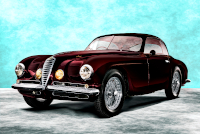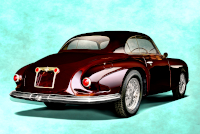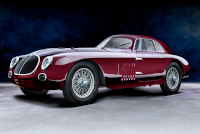Alfa Romeo 6C 2500 SS Touring Berlinetta Villa d'Este, #915902, 1950
Location:
RM Sotheby's, Miami, 2024
Prologue:
The post-War 6C 2500 is a rare bridge between classic era and modern automotive design. Despite horrific lighting conditions, I feel it is important to fit this piece into the Alfa Romeo story, and perhaps expand the visual support under better conditions. So we take an abbreviated look at the shape, which is the final derivation of the 6C 2500 SS reimagined by Touring in 1946. We'll talk of names and the subtlety of design changes that brought about this more spritely berlinetta.
Late recompense, way back in 2007 we found a beautiful 1948 6C 2500 SS at Radnor Hunt, but I couldn't survey the car properly. Not much better today in visual thoroughness, but this interstitial family of Alfa cars has long been an obvious omission. So I'll toss two quarters' worth into the portfolio and keep on the lookout for another example in this rare series.
- - - - - - - - - -
► Image Source: Nikon D750 (24.3 MP)
References:
- Czap, Nick. "Museo Storico Alfa Romeo: The Catalogue" Giorgio Nada Editore, Milano, Italia. 2015, page 118-119
- d'Amico, Stefano. "Pure Alfa Romeo" Libri Illustrati Rizzoli, Milano, Italia. 2017, page 82, 84-87, 93
- RM Sotheby's: The auction listing for chassis #915902.
- UltimateCarPage: The Villa d'Este Berlinetta demonstrated by six chassis, by Wouter Melissen, May 20, 2015. Look to #915882 for the pure Villa d'Este transformation executed in 1949. The remaining chassis, like #915902, display the final revision of the 6C 2500 SS concept.
The 6C 2500 SS emerged in 1946 from the parts and plans of the pre-War 6C 2500, and even appeared during wartime with some manner of interim Touring coachwork. And so the 6C became a rare example of automotive design continuity between the classic era and post-War era.
As it evolves into a lithe berlinetta, the 6C 2500 SS becomes a modern expression of the grand touring concept. By the close of the 6C program, Alfa Romeo will drift away from the luxury GT concept. The 4-cylinder 1900 soon takes over top spot in the stable as Alfa gradually vacate the high-end market. This shift positions the excessive 6C 2500 SS Villa d'Este more in league with the Ferrari 250 family of GT berlinetta cars. Not simply the Touring coachwork, but the whole luxurious package is indicative of designs to follow for Ferrari, particularly those created by Pinin Farina.
Technically, the 6C 2500 SS depends on pre-War technology, diminished by post-War constraints on petrol quality, creating a low-compression version of the 6C known to the classic era. This 6C 2500 SS Villa d'Este produces about 20 horsepower less than the classic era Tipo 256 motor, reached at lower peak rpm. But being an Alfa Romeo, this particular 6C competed still in the early post-War era, running the 1952 Monte Carlo Rally. RM Sotheby's describe much of the car's history, some of which we relay where the points support the story of how this GT concept transitions from Alfa Romeo to Ferrari during the 1950s.
Our aesthetics discussion pulls apart the Villa d'Este transformation from the 6C 2500 SS and defines the Villa d'Este's place in Italian GT lineage. Ironically, this car's original owner, Commendatore Vincenzo Francesco Ferrario, lived a life connected to both of these design and manufacturing themes. Ferrario lived in Bellagio, Italy, town at the point of the peninsula between the branches of Lake Como, about an hour north of Villa d'Este. RM report that Ferrario was a close personal friend of Enzo Ferrari. And in 1960, when Ferrari became Società Esercizio Fabbriche Automobili e Corse (SEFAC S.p.A.), Commendatore Ferrario served on the managing board. Ferrario is therefore something of an archetype of the 6C 2500 Villa d'Este owner. He is a man of the same geographic region as the berlinetta's namesake, the car itself being of such GT pretenses that lead directly to the Ferrari cars that Ferrario will later preside over. A complicated relationship, but the 6C 2500 SS Villa d'Este is a complicated car.
Of the car's competition history, RM write: "In January 1952 Ferrario put this Alfa Romeo through the competitive paces when he entered the car in the Monte Carlo Rally, a 3,374-kilometer trek that would take him from Palermo to Monte Carlo, through several challenging patches of inclement weather. Entered as race #194, and with a mysterious co-pilot (either V. Pellecchia or factory test driver Bruno Monini), the Villa d’Este finished 108th among 328 starting cars, of which only 163 crossed the finish line."
No one knows when chassis #915902 left Ferrario's care, but the car resurfaced in Switzerland in the 1970s. A series of sympathetic restorations brought the 6C to concours condition, and from the late 20th century into the new millennium the car toured the world. Not until 2019 did #915902 come to the US, receiving its most recent updates.
Motor: 2,443 cc inline straight 6-cylinder, cast iron block, light-alloy hemi-head | 72 mm x 100 mm | 7.5:1 compression | motor #SS928217
Valvetrain: DOHC, chain-driven, 2 valves per cylinder
Aspiration: triple single-choke Weber 36 DO2 carburetors
Power: 105 bhp at 4,800 rpm
Drivetrain: 4-speed gearbox, single dry-plate clutch, rear-wheel drive
Front Suspension: independent parallel trailing arms, coil springs, hydraulic dampers
Rear Suspension: independent trailing arms, longitudinal torsion bars, hydraulic dampers
Architecture: welded steel box section longerons and cross-members with aluminum Superleggera coachwork by Touring of Milan, body #3543
Kerb Weight: 1,420 kg (3,130.56 lbs)
Wheelbase: 2,700 mm (106.3 inches)
Top Speed: 165 km/h (102.5 mph)
Etymology:
The 6-cylinder '6C' nomenclature extends from the classic era. As before, capacity is just under 2,500 cc, and the Super Sport name carries forward as well.
The Villa d'Este name stems from the concours d'elegance at Villa d'Este on Italy's Lake Como, (the Villa d'Este Concorso d'Eleganza, which BMW revived in 1995). Carlo Felice Bianchi Anderloni's revised 6C 2500 SS Touring design won the people's choice award in 1949, thence adopting the moniker.
Many sources use the terminology, "Villa d'Este Touring Coupé," whereas one could contest the interruption of 'Touring Berlinetta' nomenclature in the post-War era. This 6C is of the same lineage and it is a berlinetta, so the switch from berlinetta to coupé feels contrived, though the change could indicate a difference in sensibility. We use 'Touring Berlinetta' here for continuity, appending the moniker. In the shorthand, 'Villa d'Este Coupé' explains the story, but without the common practice of inverting 'Touring' as the coachbuilder ahead of the body style.
Figures:
The Alfa Romeo catalogue cites 36 cars produced, though the text reads, "About thirty cars were produced before it was removed from the catalogue in 1952." This quote and the figure may refer to late cabriolet bodies produced in that final year, whereas most sources cite 32 examples of the Villa d'Este Berlinetta.
Value:
Chassis #915902 sold for $588,000 at RM Sotheby's 2024 Miami auction.
In period, the Villa d'Este cost 4,500,000 Italian lira. Using a 1950 exchange rate of 624.61 lira to the dollar, the new 1950 cost equals $7,204.50. The 6C 2500 SS Villa d'Este was not merely the most expensive car in Italy at the time, but among the most expensive in the world. Cost and exclusivity kept these cars from American eyes, less auspicious than their classic era cousins, and far less popular than the spritely mass-market Alfa cars to follow.
Touring Iterations: The Superleggera Design from the 6C 2500 SS Berlinetta to the Villa d'Este Berlinetta
This particular shape began as the classically inspired 6C 2500 SS Touring Berlinetta produced from about 1946 to 1948. In 1949, the junior Carlo Felice Bianchi Anderloni modified the shape into a more modern grand touring car, less the classic. This version became known as the Villa d'Este in the same year honoring success at its namesake concours d'elegance. One last iteration further modernized the details from late 1949 to 1951.
In its early form, the 6C 2500 SS looks a berline-type coupé (as it is often called). The rear quarters are blind without quarter windows. The eyebrows on all four fenders sweep downward in matching grace. The fascia uses a fully shrouded quad-light set with the inner driving lights housed in diminutive nacelles. Fascia and tail use a quad-guard arrangement where each of the four linear bumpers wraps around the sides, particularly at the rear. At the front, horizontal vents fit between the four narrow guards.
Along the flank, this first post-War 6C 2500 SS wears a chrome fixture along the rockers, a trait Touring will repeat on early 1900 CSS cars. And many of the cars produced through 1948 still use trafficators, tucked into the flanks just fore of the doors.
In 1949, Anderloni creates what becomes known as the Villa d'Este. The new car replaces the quad-guard tail with sculpted tail light pods of the same theme as its fascia treatment, using complex ess channels to carve out bullet-shaped protrusions. The back deck is leaner than the preceding 6C 2500 SS, and the cabin uses rear quarter glass in place of the blind quarters of the preceding car. The 1949 design uses a revised fascia in which Touring widen the channels and bevel their edges. The driving lights move close to the grille on the shelves created by the beveled channels that sweep outward toward the headlamps. The fascia then transforms its four guards into four horizontal vents along the rather flat lower valance, and Touring add a solid roundel at the base of the grille. Indicator lights fit up into the corners of the upper vents, no trafficators any longer. The flank does without chrome, and the brows on the four fenders are still swept, but only subtly at the front.
Perhaps the best example of this pure Villa d'Este design is chassis #915882. As this 1949 transformation uses no extra fixtures—no bumpers, chrome, or trafficators—the shape is unbroken from the peak of the hood to the lowermost edges. The effect is very similar to the vaunted Cisitalia 202 in its original deguarded form, and Anderloni must have taken some inspiration from Dusio's Pinin Farina exercise. The subtle curves of the fender brows are particularly graceful on #915882, but will be redrawn yet again in the next iteration.
Such a sweet moment in the design's development passes too quickly. Touring further revise the fascia in 1949, so creating a third and final version of the concept. Just a few clicks later in production, #915884 displays this final revision. The car depicted here, #915902, follows this same template, common to those cars completed in 1950 through 1951.
At the front, this final design divides the four horizontal vents longitudinally by a set of protruding guards. The guards are multi-layered and not of insignificant size. Touring set round indicators within the upper vents, and punctuated the lower point of the grille with a similar solid roundel as before, but in more pronounced relief. The tail receives a similarly large guard, underlining the sweep-channel theme. Touring break the rear bumper and insert a round light into the center, sectioning the middle in concert with the large plate frame above on the boot lid, whereas the clear round light matches the grille's roundel up front. Along the flank, Touring change the brow alignment on the fenders. The Villa d'Este now uses a linear brow at the front. This change calls upon a signature feature of Touring Superleggera coachwork in the post-War era, mimicked on Touring's early Ferrari 166 Inter Berlinetta designs as of 1947, and soon to be copied on Frank Feeley's Aston Martin DB2.
Overall, changes to the old berline-style tail transform the classic 6C 2500 SS shape into a lithe GT. The lean deck diminishes the tail in favor of the broad bonnet, which creates a leaping stance. In this way, the visual balance of the classic 6C 2500 SS of 1946-48 is much more evenly distributed at the four corners, whereas the Villa d'Este design tilts the visual dynamics like an archer who has drawn a bow and taken aim over the ramparts.
Personally, I appreciate the classical balance of the original 6C 2500 SS, but recognize the interstitial 1949 Villa d'Este is a rare gem that marries grand gestures and subtle design elements with extraordinary finesse. The final cars in this series evoke that enlightened posture of the first Villa d'Este, but lack the same degree of finesse. Not devoid of grace, there is simply a touch too much to consume, perhaps a pure shape besmirched by bumpers yet again.
Modern Berlinetta: Alfa-Ferrari Lineage in the 6C 2500 SS Villa d'Este
At this nascent stage of modern automotive development, the Alfa is more mature, its development dating back over a decade. But just as Alfa Romeo changes its market economics in favor of scale, so will Ferrari grow into the luxury space. Whereas a spartan 1947 Ferrari 166 Inter Berlinetta predicts the Alfa Romeo 1900 CSS yet to follow, (both Touring Superleggera exercises), the 6C 2500 SS Villa d'Este rather predicts the 250 GT Berlinetta Lusso.
Of course Pinin Farina becomes prominent in the Ferrari catalogue, but the Touring idea is foundational in post-War berlinetta development. Even Lamborghini begins its story with the same design ethic more than a decade later, with ess-channel design cues on the 350GT of 1964.
As for Ferrari, once the 250 comes into form, the exotic sports car world becomes laser-focused its many variations. But through the early 1950s, Alfa Romeo and Ferrari cross over one another with similar Touring berlinetta design exercises, the former trending toward the broader market and the latter becoming more specialized in that very same way Alfa Romeo had been in the classic era. The 6C 2500 SS—and the Villa d'Este in particular—epitomizes that GT criss-cross. In the Villa d'Este, one can look backward into the Alfa Romeo catalogue or forward into the Ferrari catalogue in the sense that both marques exist on the same Italian GT design spectrum.
Grand Luxury: Commonalities of the Post-War Alfa Romeo Villa d'Este and Talbot-Lago GSL
Rather like a gemstone cut with excessively complex facets, light reflects off the Villa d'Este body in unexpected directions, with curves and channels providing jewelry mounts for the lights and fixtures. These complications are remnants of classic era grand luxury updated for a modern world.
Talbot-Lago exercised a similar approach with the T26 GSL. To say nothing of the amazing coachwork of Pourtout and Saoutchik, the beautifully proportioned GSL reinvents the T26 in much the same way as the Villa d'Este reinvents the 6C 2500 SS. Perhaps the Talbot-Lago does not demonstrate the same continuity of design through the War years, but the 6C 2500 SS Villa d'Este and T26 GSL are close in ideology. (Much more than the Delahaye 135, which Chapron and Figoni didn't quite reinvent for a new era so much as they reinterpreted their own classic era designs.)
As we mentioned, these bridge design exercises are rare; it is tough to find adequate counterpoint for the 6C 2500 SS. And 1940s design ingenuity is a special artefact for countries ravaged by World War II. That story, perhaps more than coachwork connections to Ferrari, is the broader triumph. Each industrial survivor wanted to wake up from war and produce an amazing car. Whether the technical sophistication could even match that of the classic era did not matter, (and of course it fell short). The point is to celebrate new ideas, spare no expense.
Last Updated: May 30, 2025
© Copyright 2008-2025, 12cylinders.com | images and text by Dominic Anthony



